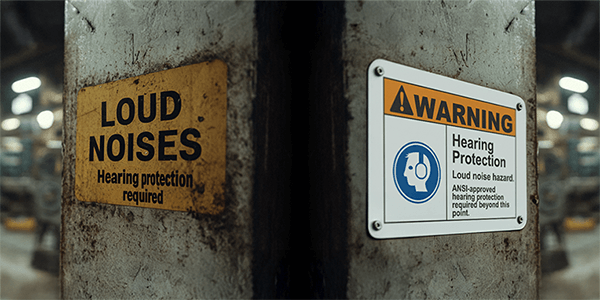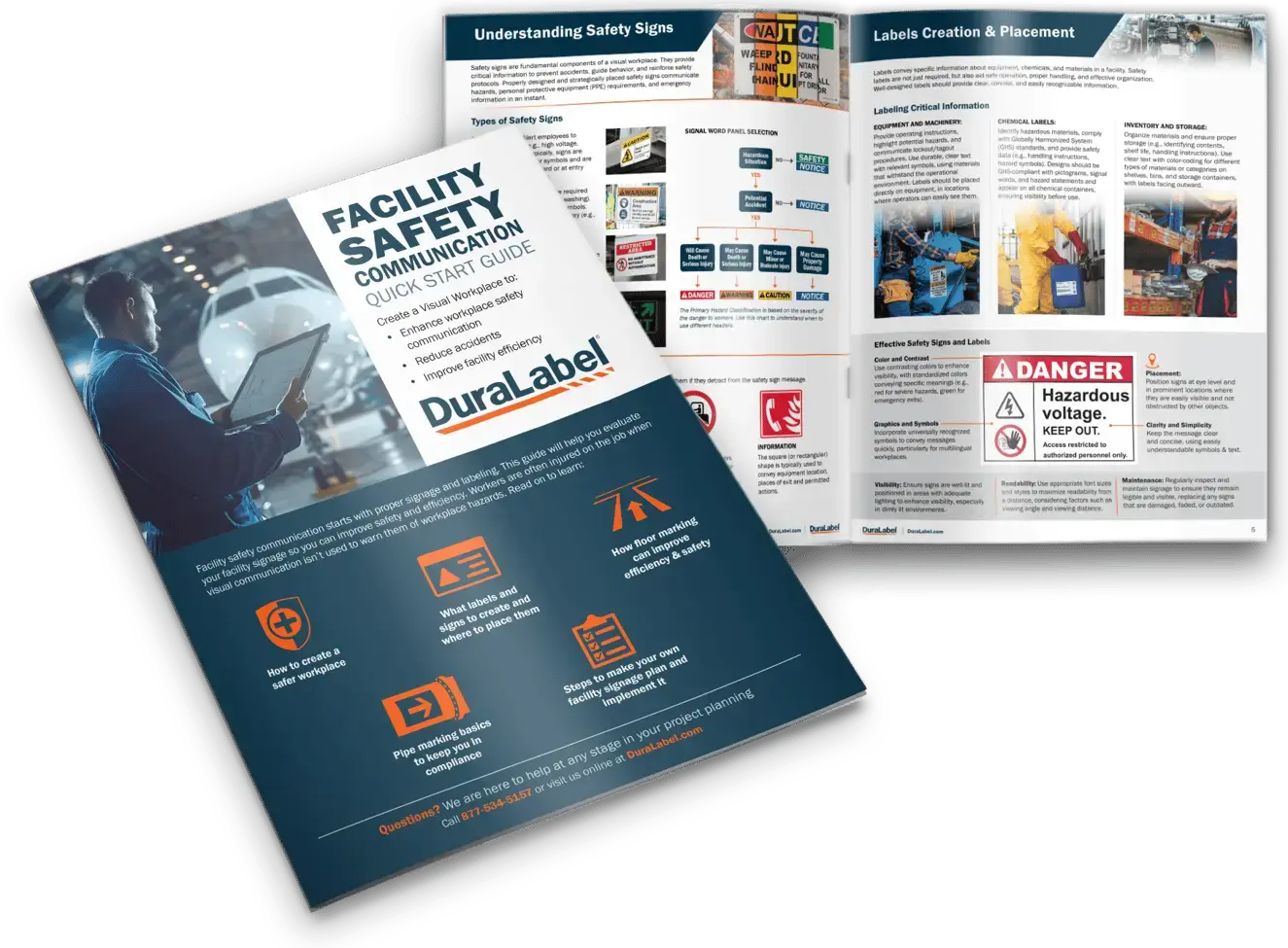How OSHA and Multilingual Signage Promote Safer Workplaces

Why is Multilingual Signage Important?
Multilingual safety signage helps prevent workplace accidents and ensures all employees understand critical safety messages. As workplaces become more diverse, multilingual signage ensures consistent communication regardless of an employee’s primary language.
From workplaces and public spaces to transportation hubs and construction sites, the presence of clear and comprehensible safety signs in multiple languages is essential to promoting safety, compliance, and inclusivity. This article explores how OSHA sign compliance, the OSHA HCS Hazard Communication Standard, and bilingual workplace signage improve workplace safety.
 There are over 350 languages spoken in the United States, according to the US Census Bureau, with some of the most widely spoken being Spanish, Chinese, Tagalog, Vietnamese, and Arabic.
There are over 350 languages spoken in the United States, according to the US Census Bureau, with some of the most widely spoken being Spanish, Chinese, Tagalog, Vietnamese, and Arabic.
More than 1 out of 6 people are foreign-born workers, according to data collected in 2020 by the U.S. Bureau of Labor Statistics (BLS). 17 percent of the U.S. workforce was born in another country and may speak a language other than English. It is important to communicate effectively with employees in every industry. Safety messaging must be understood by all employees, regardless of demographics.
The BLS reported the workforce demographics across all industry sectors comprised of:
- 77% White
- 19% Latino
- 13% Black or African American
- 7% Asian
Companies seek the best workers available, from all cultures and backgrounds. A diverse workforce may include multiple native languages among workers. Language barriers can lead to miscommunication, decreased productivity, and difficulty during group collaboration.
A good way to fix the language barrier issue is to create a level playing field with signage in the languages spoken by workers at your facilities. Multilingual safety signage can be useful in several ways, such as:
How Do Multilingual Signs Enhance Safety Signage and Compliance?
The primary function of safety signage is to prevent accidents and injuries by providing clear instructions and warnings. In environments where people speak different languages, signs not presented in the primary language of the workforce can lead to misunderstandings and hazardous situations. Multilingual signs help prevent these misunderstandings and ensure that everyone has the same opportunity to follow safety protocols.
Research conducted in 2017 by Dr. Matthew Casey at Akorbi found that multilingual safety signage significantly improved workplace communication. According to OSHA, workplaces that implemented multilingual signage saw a 25% reduction in job-related accidents because non-English speakers better understood safety protocols. This improvement aligns with hazard communication expectations found in OSHA HCS.
Organizations can meet regulatory requirements that mandate effective communication of safety information by providing proper safety signage in multiple languages.
How OSHA HCS and OSHA Regulations Support Multilingual Signage
Many countries have regulations and standards that mandate the use of multilingual signage in workplaces and public areas. OSHA sign compliance recognizes that language can be a safety barrier and requires that signs must be posted in both English and the primary language spoken by the workforce if English is not the primary language.
OSHA HCS requires safety data sheets (SDS) and labels to be provided in languages spoken in the workplace. This often leads organizations to translate other safety documents and signage to support full comprehension.
When creating custom signage, universally recognized symbols and pictograms should be used to bridge language gaps. ANSI Z535.1 outlines technical definitions and color standards, while ANSI Z535.2 regulates the design and use of safety signs within facilities.
Compliance with OSHA regulations helps organizations avoid penalties and demonstrates a commitment to worker rights and safety.
OSHA Compliance Helps Promote Inclusivity and Accessibility
Bilingual workplace signage makes information accessible to a wider audience. Multilingual signage caters to speakers of both dominant and minority languages, ensuring that everyone can understand critical messages, instructions, and information.
In multicultural organizations, inclusivity is vital. Providing safety information in multiple languages helps create a sense of belonging and ensures everyone can navigate their work environment safely. This aligns with guidance in OSHA HCS, which emphasizes accessible hazard communication.
How Multilingual Signs Improve Efficiency and Productivity
Clear communication is key to maintaining efficiency and productivity in the workplace. When safety instructions are easily understood by all employees, the risk of accidents and errors decreases, leading to smoother operations.
A key component of maintaining a safe work environment is comprehensive and effective training. According to research conducted by Seyens, 80% of human learning occurs through the processing of visual information. Safety signs accompanied by images and other visual tools offer an ideal medium to capture workers’ attention and convey important safety messages. Workers can better understand the risks associated with their work environment when visual tools are incorporated into safety training programs.
The training should be reinforced through visual imagery throughout the job site, because workers can significantly reduce the likelihood of an accident with the knowledge they were given to be able to recognize and avoid potential hazards.
Multilingual safety signage is also effective at reducing the need for additional training or translation services, which can ultimately save time and resources. Employees who feel safe and well-informed are more likely to perform their tasks confidently and efficiently.
DuraLabel Safety Signage Resources
Multilingual safety signage is more than a regulatory requirement. It is an important component of effective safety management and inclusive communication. Organizations can enhance safety, compliance, and accessibility by addressing the linguistic diversity of individuals.
DuraLabel's free LabelForge PRO software comes preinstalled on the Toro Max and Kodiak Max print systems. The software allows users to design and print custom signs and labels for any situation. With the latest version of the software, users can now break through language barriers in their workplace by creating compliance and custom labels in 14 languages.
Through careful planning, professional collaboration, and ongoing commitment, organizations can ensure that their safety signs are understood, regardless of language.
Learn more about DuraLabel’s free OSHA Safety Signage Quick Start Guide. It provides users with best practices for labeling under OSHA and ANSI requirements and standards. It also helps create OSHA/ANSI-compliant safety signs, all while providing a facility site inspection checklist. Download your free guide today and call 1-888-820-4631 to speak to a safety professional who can guide you through the process.
Read Next:
Maximizing Productivity: 4 Tips for Optimizing Field Printing Processes
Related Resources

5 Ways to Make Workplace Safety Signs Stand Out
How Safety Signage Improves Hazard Communication and Employee Awareness Workplace safety signs play a key ...
Read
Marine Corps Air Facility Adds App, Steps Up Safety Program
A safety team at the Marine Corps Air Facility (MCAF) in Quantico, Virginia, tackled safety issues and ...
Read
How Custom Vinyl Labels Help Facilities Boost Safety and Compliance
Why Are Premium Custom Vinyl Labels Important forWorkplace Safety? Premium custom vinyl labels are gaining ...
Read.png)





